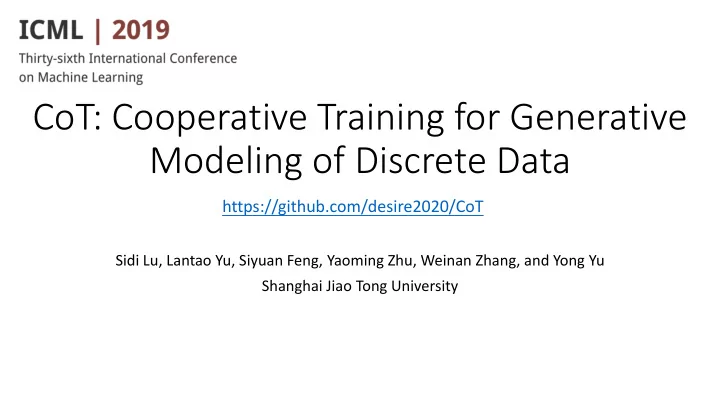

CoT: Cooperative Training for Generative Modeling of Discrete Data https://github.com/desire2020/CoT Sidi Lu, Lantao Yu, Siyuan Feng, Yaoming Zhu, Weinan Zhang, and Yong Yu Shanghai Jiao Tong University
Autoregressive Models • Autoregressive models factorize the distribution sequentially to build a fully tractable density function: • 𝑞 𝜄 𝑦 0 , 𝑦 1 , … , 𝑦 𝑜−1 = 𝑞 𝜄 𝑦 0 𝑞 𝜄 𝑦 1 𝑡 [0:1) )𝑞 𝜄 𝑦 2 𝑡 [0:2) )𝑞 𝜄 𝑦 3 𝑡 [0:3) ) … 𝑞 𝜄 𝑦 𝑜−1 𝑡 [0:𝑜−1) )
Teacher Forcing and Exposure Bias • For each sequence in the training set, maximize the estimated likelihood in the log scale: initial state p(x|s) p(x|s) p(x|s) Model Model Model forced forced estimate estimate ··· observation observation I have
Teacher Forcing and Exposure Bias • When used to generate random sample: initial state p(x|s) p(x|s) p(x|s) Model Model Model self self stochastic stochastic ··· observation observation sample sample Billie Jean
Teacher Forcing and Exposure Bias • Exposure Bias [Ranzato et al., 2015]: • The intermediate process under training stage and inference stage is inconsistent. • The distribution shift would accumulate along the timeline. Teacher Forcing Real p(x|s) Model Training Prefix Random Sampling Generated p(x|s) Model Inference Prefix
Exposure Bias and Kullback-Leibler Divergence • Exposure Bias could also be regarded as a result of optimization via minimizing Kullback-Leibler Divergence, denoted as KL(P||Q) for measured distributions P, Q.
Kullback-Leibler Divergence, Symmetry of Divergences • For any P, Q, KL(P||Q) not necessarily equals to KL(Q||P) • KL ---smoothed and symmetrized--> Jensen-Shannon Divergence • where M = 0.5 * (P + G)
GAN, SeqGAN and Language GANs • Ian Goodfellow proposed Generative Adversarial Network [2014] • Ideally, GAN minimizes the JSD • Can’t be directly applied to discrete sequence generation • SeqGAN uses the REINFORCE gradient estimator to resolve this.
Problems of SeqGAN • Not trivially able to work from scratch. • SeqGAN’s work-around: Pre-training via teacher forcing. • Trade diversity for quality (mode collapse) • According to previous reports([Lu et al. 2018; Caccia et al. 2018])
Problems of SeqGAN • Training signal is too sparse. initial state p(x|s) p(x|s) p(x|s) Generator Generator Generator self self stochastic stochastic observation observation sample sample Billie Jean single point signal single point signal Discriminator
Cooperative Training: Back to Formula! • Reconsider the algorithm from estimating & minimizing JSD: • where M = 0.5 * (P + G) • Instead of using a discriminator to achieve this, use another sequence model called “Mediator” to approximate the mixture density M.
Cooperative Training: More Information from Mediator • Key Idea: The mediator provides DISTRIBUTION level signal in each time step. Generator Generator Generator initial state G(x|s) G(x|s) G(x|s) Billie Jean signal signal signal M(x|s) M(x|s) M(x|s) Mediator Mediator Mediator
Cooperative Training: Factorizing the Cumulative Gradient Through Time, Final Objectives • Generator Gradient: • where 𝜌 𝑡 𝑢 = 𝐻 𝜄 𝑦 𝑡 𝑢 , 𝜌 𝑛 𝑡 𝑢 = 𝑁 𝜚 𝑦 𝑡 𝑢 , • Mediator Objective:
Experiment: Synthetic Turing Test
Experiment: Real World Data Quality Test on EMNLP2017 WMT Reasonable Diversity Test on News Section EMNLP2017 WMT News Section
Poster #44 Conclusion • Key Ideas: • Use a max-max game to replace min-max game of GANs, while still focusing on minimization of JSD. • Use distribution-level signal from the introduced mediator in each step. • Advantage: • Works from scratch. • Trade-off invariant performance gain while still being computationally cheap enough.
Recommend
More recommend